Barefoot running sandals are the next best thing after… Well, barefoot running, I guess. I wanted to try out the Huaraches Sandals.
Do you think running barefoot is awesome?
Me neither.
First, I want to be clear I don’t think we should get back to our roots and run barefoot because cavemen didn’t have Nikes.
I just want to be a better runner.
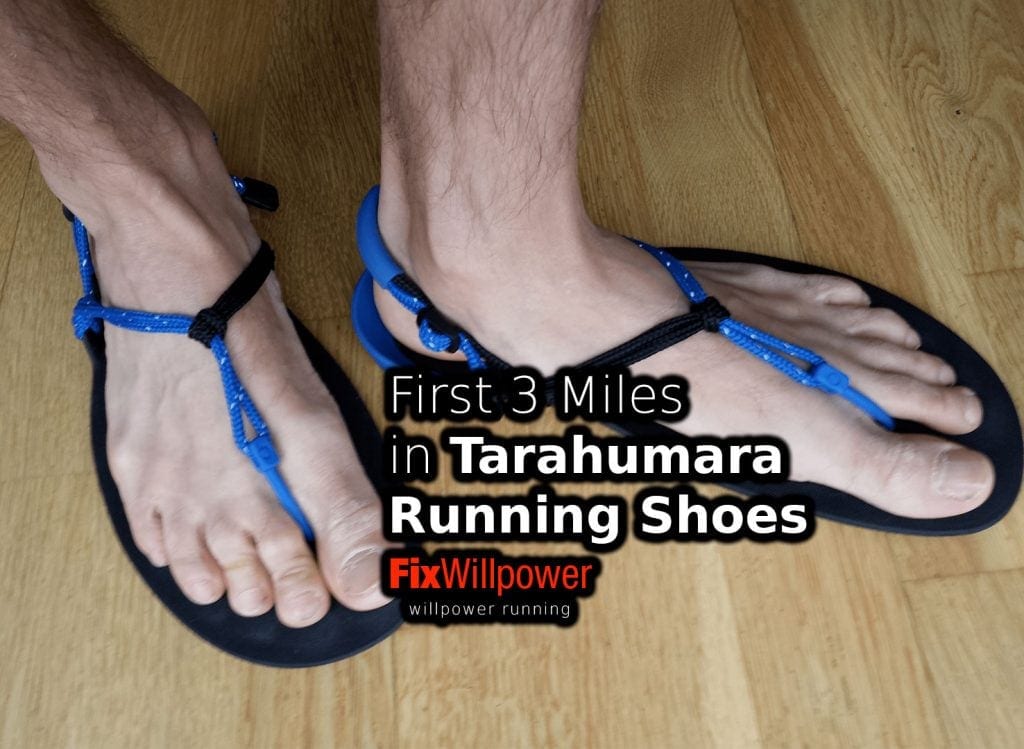
If tech from 10,000BC will help me with that, great!
If not, “Hello, 21st century!”
Key Points for Barefoot Running Sandals Experience
- Adapting to Minimalist Footwear: Transitioning to huarache running sandals, inspired by the Tarahumara people, can enhance your understanding of natural running techniques. Initial discomfort with lacing and adjustments is common. Experimentation and practice are key to finding the perfect fit. What next? Begin with short distances and gradually increase to allow your feet to adapt. Pay attention to lacing and strap adjustments to ensure comfort.
- Running Technique and Performance: Barefoot running sandals require a focus on proper running form, particularly toe-strike running. This can prevent common injuries associated with heel striking. However, mastering this technique can take time and practice. What next? Work on your cadence and running form before switching to minimalist footwear to transition smoothly and prevent injuries.
- Breaking in and Adjusting: Like any new running gear, huarache sandals need a break-in period. Expect minor issues such as blisters or discomfort during the initial runs. These usually subside as your feet adjust to the new footwear. What next? Start with indoor training or short runs on a treadmill to minimize the risk of blisters. Gradually increase the distance as you get used to the sandals.
- Practical Usage Beyond Running: Huarache sandals can be used for various activities beyond running, such as walking and hiking. They offer a closer-to-nature experience and can help in understanding natural foot mechanics. What next? Incorporate huarache sandals into your daily routine for walking or light hiking. This will help you adapt more quickly and understand their benefits in different scenarios.
- Evaluating Long-Term Benefits: The long-term benefits of running in huarache sandals include stronger feet and improved running form. However, they may not be suitable for everyone, especially for ultrarunning or those who prefer cushioned shoes for long distances. What next? If aiming for stronger feet and better form, integrate minimalist running sandals into your training. Monitor your performance and comfort over several miles to decide if they are right for you.
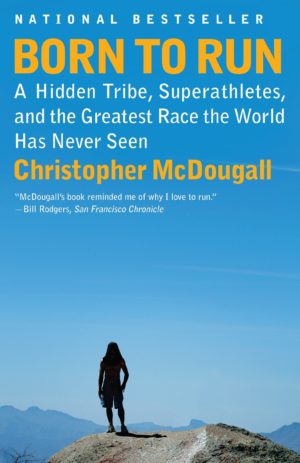 The Born to Run book
The Born to Run book
When I finished reading Born to Run by Christopher McDougall and decided to experiment with the minimalist running style of Tarahumara people. The first brilliant idea was to make my own huarache running sandals out of tire rubber and some string. I headed to Youtube to find some instructional material about how to make huaraches sandals.
After watching some videos and considering the great success of my previous DIY projects, I decided to find out where to buy huaraches sandals.
Much easier!
In no time, Google sent me to Xero Shoes website. A little bit later, after reading forums and reviews, I was ready to buy.
A great way to learn about a new location is a running tour. When you visit Estonia, come to a running tour of Tallinn with me.

I wanted to make absolutely sure that the Tarahumara sandals fit, so I printed out the sizing instructions and then placed an order for Ready-to-Wear Men’s Barefoot Sandals. I opted for the most “hi-tech” version as I wanted 21st-century comfort with my stone age Tarahumara sandals.
As it happens, I live in the middle of nowhere, and this means that the delivery takes weeks and costs an arm and a leg. But no problem, Estonia is a polar bear country, and it was a bit cold for the barefoot running anyways.
So, after three weeks, I got my huarache running sandals.
I couldn’t resist trying them out right after I got the package from the post office. It was about 30F (0C) outside, but I ran a few hundred yards. Fast forward another 3 weeks, and it’s 65F (18C) outside. I decide to go for a walk in my brand new barefoot running sandals:
Putting on huaraches running sandals
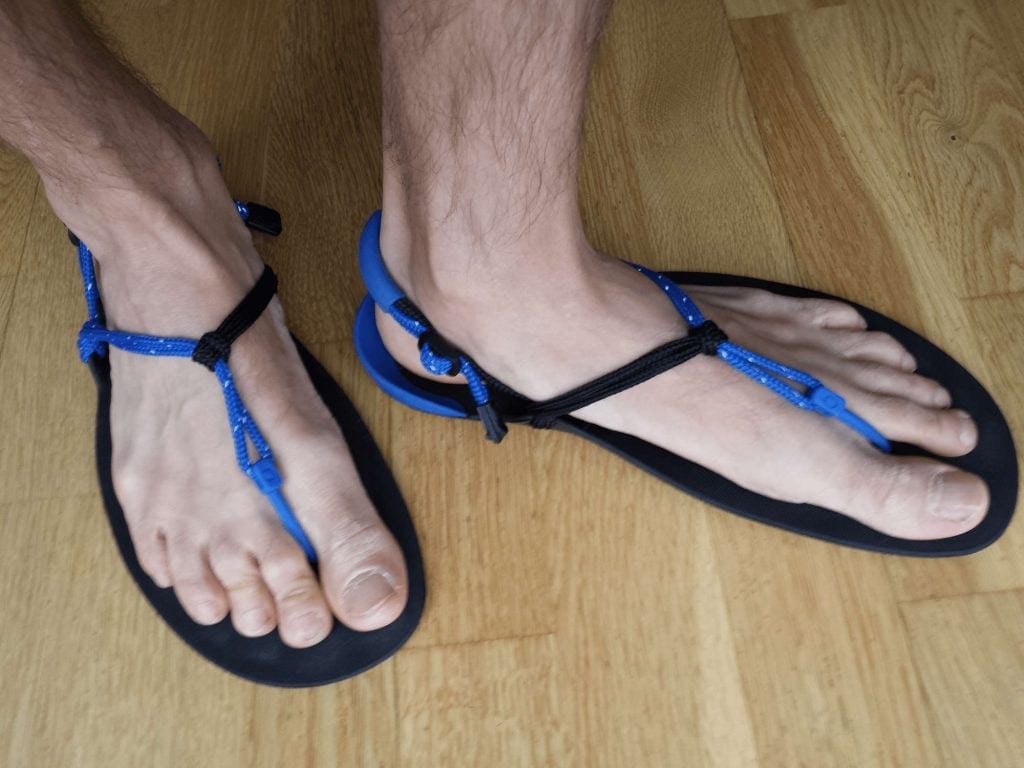
The first thing I had to do for my Tarahumara running sandals review was to put them on. Now, when the rubber meets the road, I need the lacing to fit perfectly. I fiddled with the laces for about a few minutes, and then everything seemed OK.
Barefoot running sandals review, the first steps in huaraches sandals
In about 50 steps, I feel that the right and left foot are laced differently, and the right foot feel uncomfortable. I experiment with the laces, but the right foot still doesn’t feel right.
I try to run.
Slowly.
After 100 steps or so, the heel strap starts to slide down. I stop and take off the sandal to put some thought into it. Sure enough, a little bit of pulling here and pushing there seems to fix the problem.
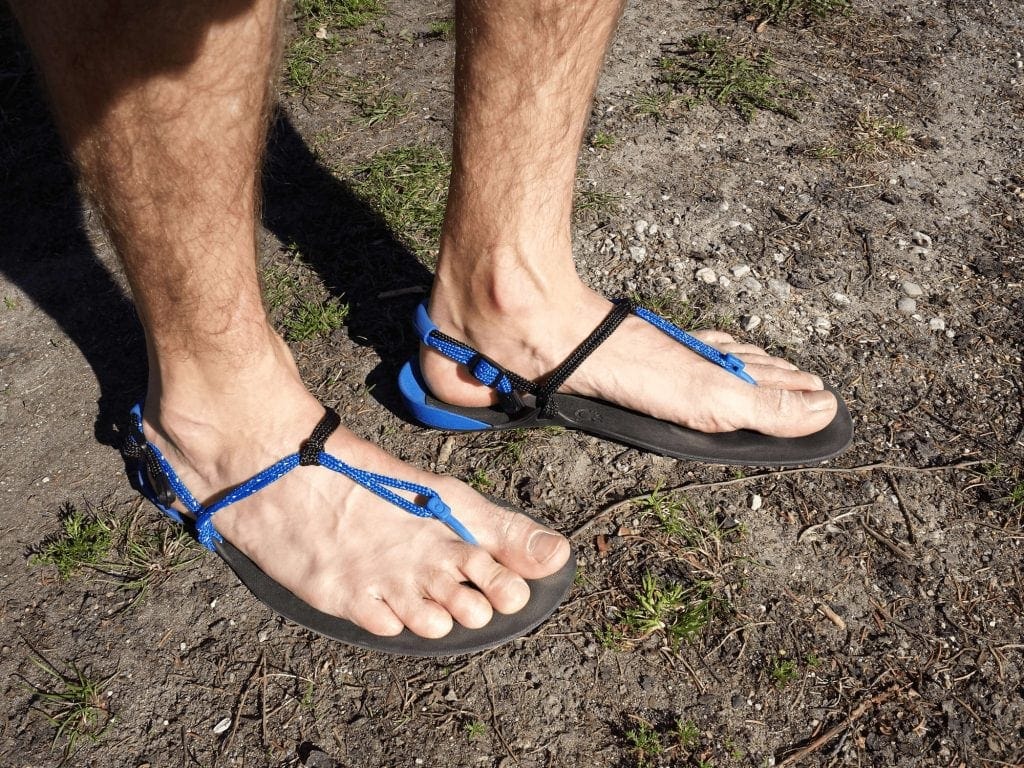
First, run in huarache running sandals
Now I’m some quarter mile out, and it feels comfortable enough for some light running of 9 minutes per mile. I start my Endomondo sports tracker to record the historic moment. And in no time there’s the first challenge, a short but steep descent.
I’ve never been good at downhill running. When you have a regular running shoe, you are not afraid of sliding off the sole of the shoe when going downhill and putting your foot in front of your center of mass. Your knees will hate you for that, but no big deal.
In huaraches, you have to think about landing your toes under your body where the arrow from your center-of-mass points. Landing on the center of mass means that you are not braking, and you have to find other ways to regulate your speed. I shortened my step increased the frequency. Cadence is something I need to practice so I can regain the energy spent on the uphill parts of the course.
Next few miles in huaraches
Everything that followed was quite uneventful. I have been running toe-strike for a long time, and in that sense, there really was no difference. If you have a good running technique, you can run in anything.
Every time I paid attention to my running, I had the feeling that the huarache sandals will fall off. However, when I was thinking about other things and moving on autopilot, then the shoes actually stayed on.
Go figure!
How do you break in huaraches sandals?
You have to get use to the shoes and then they work perfectly.
By the end of the second mile, I had to stop and adjust the straps on my right sandal as the heel strap started to slide down. That was the last adjustment I needed to make. Considering how many miles it takes to “run in” regular running shoes, a few miles seems quite good.
Oh, my goodness! A blister!
After walking half a mile and running another 2.5 miles, I had a blister on the fourth toe of my right foot. It resulted in the combination of less than perfect lacing and my constant fear of the sandals falling off. So I tried to grab the sandal with my toes, and the friction from that movement caused the blister. I expect not to have more of these after I get used to the huaraches sandals and won’t try to grab them anymore.
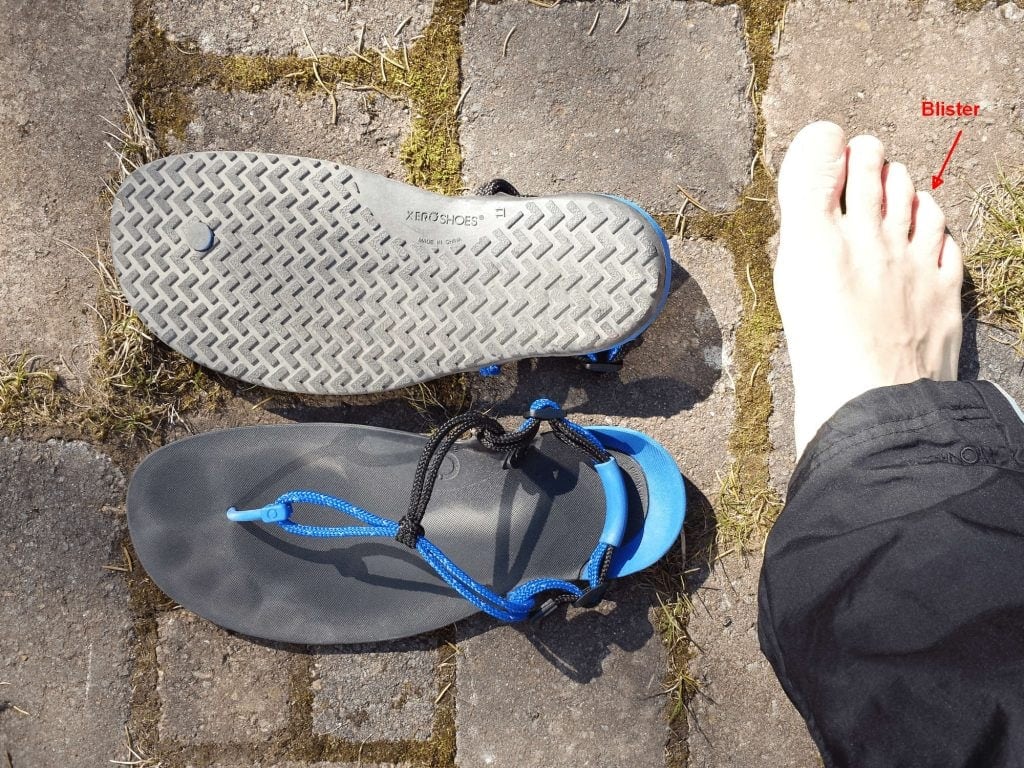
Some of my friends pointed out that I will have blisters between my big and second toes where the silicon thing attaches to the sole. No problems there!
To be on the safe side, you could start training with barefoot running sandals on a treadmill, or you could try to run an indoor marathon.
No problems running with Huaraches sandals

If you are a heel-striker, there will be a learning curve. But you have to change, or you bust your knees.
Will I run my next marathon in huaraches? I don’t know. I have to run more in huaraches sandals to get a better understanding (100-200 miles maybe).
The main question: Is there an advantage over the regular running shoe, more effective style, stronger feet?
I don’t know if I would use the huaraches sandals for ultrarunning, but that’s what they do.
One thing I know, all my next “real” running shoes will have a thinner sole.

I could feel my anger dissipating as the miles went by–you can’t run and stay mad! ~ Kathrine Switzer
Using running sandals for everyday walking
I still mostly run in my running shoes, but the running sandals helped me better understand how running works.
Now I regularly use the running sandals for walking and hiking in the summer. And, of course, from time to time, when you walk, you have to run, and then I do it in the barefoot running sandals.
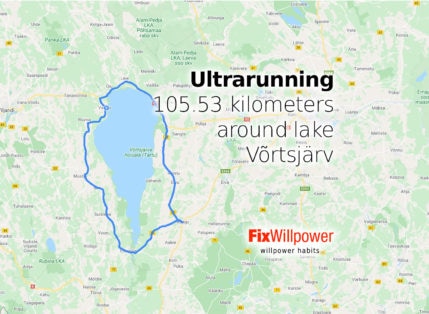
![Read more about the article How to Relieve Lower Back Pain [1 exercise, 1 minute]](https://fixwillpower.com/wp-content/uploads/lower-back-pain-429x314.jpg)
![Read more about the article Go for a Walk to Boost Your Well-Being [VIDEO]](https://fixwillpower.com/wp-content/uploads/willpower-habit-walking-429x314.jpg)

It took me a few months to warm up to my huaraches, despite being a barefoot-style shoe wearer for a few years. You have to get used to between-the-toes strap and some wiggle (it’s only held on by strings!), but now I’m hooked for running. What changed it for me, however, is that I don’t think of them as shoes, but rather foot-protectors for running barefoot. You should run with with a form as cautious as being barefoot when running in huaraches or else you’ll probably stomp too much in these, which will lead to problems.
Thank you for your comment! This is a great way to think about those shoes.
when I switched to barefoot running I started slow because you will have to build up the muscles in your feet and calves so it takes time. It took me a good 8 months to get used to actually running in minimalist shoes, it is the best thing I ever did for myself, I would never ever consider using shoes again to run, they are, in my opinion, harmful because they teach us how to walk with support and the muscles that you would normally use become too relaxed and cause a whole bunch of issues with your back and knees and feet. Take your time and don’t try to run a marathon your first day, you will be super upset and it will take a week to recover properly. Enjoy!
Spot on, Robert! Many people just switch to sandals and continue as nothing happens. Then they say that sandals don’t work for them. You have to take the time to adjust. For example, when I started to change my heel strike to toe, it took me almost a year. Telling myself 1,000,000+ time “toe first, toe first, toe first, toe first, toe first…”
Does it hurt when you run almost barefoot?
Thank you for your question, Kirk!
The most important thing is not to run in a way that you land on your heels. You can try it yourself. Find a very smooth surface to run on or do it indoors. Run without shoes and you notice that you when you land mid-foot or on the front of your foot your legs and knees work as shock-absorbers.
It does if you start to run too fast or too long distances. Your calf will suffer.
I am in the process of going minimalist (barefoot in my case as a first chapter) and I increase my running distance by 300 m (starting at 1 km) every 3 days. Calf and feet are feeling a bit of “normal” pain but it disappears before the next session (it has to before you run again).
David does it in a right way. When you try new things always start small and go by small increments.